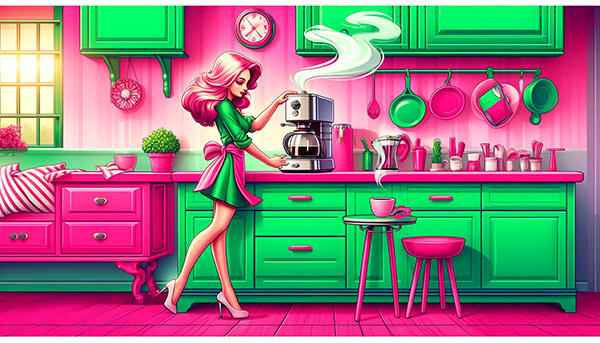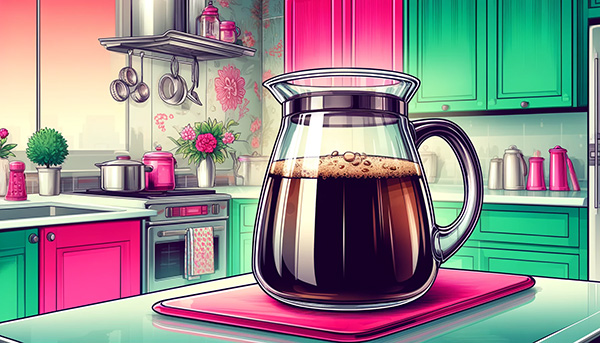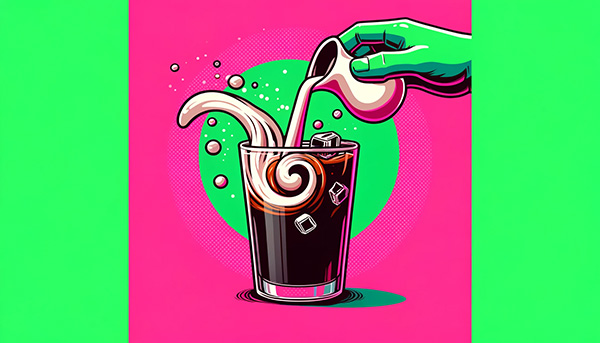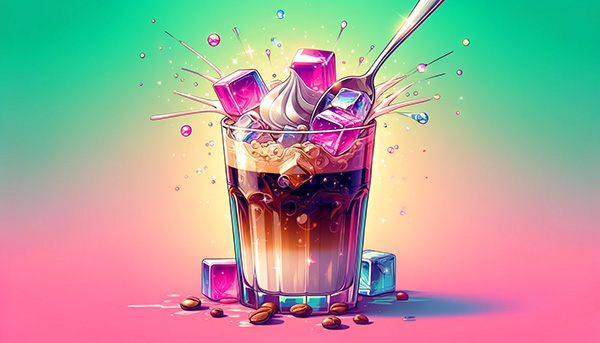As the sun stretches its golden rays across the morning sky, there's something undeniably refreshing about sipping on a chilled, invigorating glass of delicious iced coffee. The rich, smooth coffee flavors and the crisp embrace of ice create a symphony of sensations that's hard to resist, especially on warm days or when you're seeking an energizing pick-me-up. If you're tired of shelling out big bucks at your favorite trendy coffee shop or love iced coffee, it's time to take matters into your own hands and learn the art of crafting the perfect iced coffee in the comfort of your kitchen.
But, hold on a moment. This isn't just about tossing some ice cubes into leftover coffee and calling it a day. Iced coffee done right is a meticulous process that involves the right coffee beans, brewing techniques, and a dash of creativity to achieve a drink that's not only chilled but also bursting with flavors.
In this guide, we will explain the steps, tips, and tricks for creating a refreshing glass of cold coffee that will make every morning feel like a cool celebration.
What Is An Iced Coffee
Iced coffee is a refreshing coffee drink crafted by brewing coffee and subsequently cooling it with the addition of ice. It's a popular choice, especially during warmer months, for those who enjoy the taste of coffee but prefer a refreshing and cold drink. There are numerous approaches to crafting iced coffee, with various brewing techniques at your disposal. It's common practice to personalize iced coffee by incorporating milk, cream, sweeteners, and flavor enhancements that align with each person's unique tastes.
What Is The Difference Between Iced Coffee And Cold Brew?
Iced coffee and cold brew are both chilled coffee beverages, but they are prepared using different brewing methods, resulting in distinct flavor profiles and characteristics.
Iced coffee is typically made by brewing coffee, similar to how you would make a regular cup of coffee. The hot brewed coffee is then cooled down by pouring it over ice. This method is quicker than a cold brew and uses traditional coffee brewing. Cold brew entails immersing coarsely ground beans in cold or room-temperature water for an extended duration, typically 12 to 24 hours. Notably, this method abstains from utilizing heat throughout the brewing procedure.
Since iced coffee is made using hot water, the beans are exposed to higher temperatures, which can result in a more complex and aromatic flavor profile. Nevertheless, hot brewing can accentuate certain acidic and bitter elements within the coffee. In contrast, cold brew is renowned for its velvety and notably less acidic flavor profile. The extended steeping time and absence of heat in the brewing process can result in a milder coffee concentrate, focusing on the coffee's natural sweetness and lower levels of bitterness.
How To Make Iced Coffee
Ingredients
- Freshly roasted coffee beans
- Cold, filtered water
- Ice cubes
- Milk or cream (optional)
- Sweeteners or flavorings (optional)
Equipment You'll Need:
- Coffee grinder
- Coffee maker (e.g., drip brewer, French press, AeroPress)
- Pitcher or carafe
- Stirring utensil
- Glass or cup
Step 1: Choose Your Coffee Beans

Start by selecting high-quality beans. Opt for beans with flavors and aromas that you enjoy. Light—to medium-roasted beans tend to highlight more delicate and nuanced flavors, which work well in iced coffee.
Step 2: Grind Your Beans

Grind your beans to a medium-coarse consistency. This is coarser than what you'd use for hot coffee to prevent over-extraction and bitterness when the coffee is cooled.
Step 3: Brew The Coffee

Choose your preferred brewing method. There are a few different ways to make iced coffee:
Hot Brewed and Chilled: This is one of the simplest methods. Brew coffee using your preferred method (drip, pour-over, French press, etc.) with a slightly stronger coffee-to-water ratio than usual. Let the freshly brewed hot coffee attain room temperature before chilling it in the refrigerator. When serving, pour the chilled coffee over ice.
Flash Brew: Like hot brewed and chilled, the flash brew method involves brewing coffee with hot water but using a stronger coffee-to-water ratio. Once brewed, immediately pour the hot coffee over a cup filled with ice. The quick cooling helps preserve the coffee's flavor.
Cold Brew: Cold brew is a natural choice for making iced coffee. Prepare a batch of cold brew concentrate using coarsely ground coffee and either cold or room-temperature water. Dilute the concentrate with water, milk, or alternatives when serving over ice. The outcome is a silky and gentle iced coffee.
Japanese Iced Coffee: This method combines both hot and cold brewing benefits. Employ a pour-over technique to brew coffee directly onto a bed of ice. The hot coffee drips over the ice, cooling and instantly chilling it. This method helps retain the intricate flavors of the coffee.
AeroPress Over Ice: Brew coffee using the AeroPress as you normally would, but brew directly over a cup filled with ice. The brewed coffee will cool down immediately as it comes in contact with the ice, resulting in a refreshing iced coffee.
Cold Drip Coffee Tower: If you want to experiment, cold drip towers are a unique way to make iced coffee. Water drips over coffee grounds slowly, extracting flavors over several hours. The resulting coffee concentrate can be enjoyed when poured over ice.
Step 4: Chilling And Dilution

Once your coffee has been brewed, allow it to reach room temperature. If time is of the essence, you may expedite the cooling process by transferring the brewed coffee to the refrigerator. It's advisable to refrain from directly pouring hot coffee onto ice, as this could result in dilution and a reduction in flavor richness.
Step 5: Fill The Glass With Ice

You can't have iced coffee without plenty of ice! Of course, the ice will melt over time. To prevent the risk of diluting your drink, a useful technique is crafting ice cubes from the coffee itself!
Creating coffee ice is straightforward: just fill ice cube trays with coffee and allow them to freeze overnight. They will keep your iced coffee chilled but won't change its flavor as it melts. No matter the variety of ice you opt for, ensure your glass is brimming to the rim. To evoke a café-like ambiance, consider using crushed ice.
Iced coffee typically isn't served in a mug. You need something that can hold more volume since the ice takes up a lot of space. Many iced coffee lovers will use a mason jar, but any tall glass you have on hand will work.
Step 6: Pour Coffee Over The Ice

Add coffee to the ice in the glass. Don't use freshly brewed hot coffee—your ice will melt away too quickly! Instead, use coffee that is room temperature or chilled. You have several choices when it comes to the type of coffee to use.
Leftover Coffee—If you need a little pick-me-up in the afternoon and there's leftover coffee from your morning cup in the coffee maker, this is the perfect way to use it up!
Instant Coffee—Freshly ground coffee does have a fuller flavor, but sometimes you just need caffeine—STAT! In that case, stir some instant coffee granules into cold water and use them to make your iced coffee. Decaf coffee crystals work the same way if you need to avoid the buzz.
Cold-brew Coffee—This takes a bit more planning, but it's worth it if you plan on drinking iced coffee regularly. The cold-brew technique entails immersing coarsely ground coffee in cold water for a minimum of 12 hours. If you like strong coffee, let it steep for a full day! You can cold-brew a few servings worth of coffee at a time and store it in the fridge.
Espresso Shots—If you have an espresso maker and espresso beans, brew two espresso shots and use them as your coffee! You'll need to let them cool down slightly before adding them to the ice.
If you plan on using regular ice cubes, remember that the coffee flavor will get diluted as the ice melts. You can avoid a weak flavor by using dark roast beans or coffee concentrate, which will make your coffee flavor as strong as possible.
Step 7: Add Cream

While you can definitely enjoy a "black" iced coffee, most of us enjoy our caffeine in a lighter shade of brown. You can use full cream, half-and-half cream, whole milk, sweetened condensed milk, almond milk, oat milk, coconut milk...or homemade nut milk, it's entirely up to you! There are options for people needing to avoid dairy products and for those who want that rich and creamy texture in their iced coffee.
Step 8: Add Extra Flavors

Your iced coffee is ready now! But why stop there? Numerous techniques exist to infuse additional flavors and sweetness into your iced coffee! You can enjoy coffeehouse-style flavored iced coffee at home with just a few add-ins.
Sweeteners—To sweeten your coffee, you can use a few spoonfuls of sugar or your preferred sugar substitute, maple syrup or honey. You also have the option to acquire (or craft your own!) simple syrup, a mixture of sugar and water that has been boiled down to achieve a syrupy consistency.
Vanilla Bean—Would you like a vanilla iced coffee? There are many types of flavored simple syrup available in grocery stores, so adding a bit of vanilla syrup to your iced coffee will give you a delicious iced latte. Or you can use a different type of sweetener, which is already mentioned, and just add a drop or two of pure vanilla extract.
Chocolate—Maybe chocolate is your flavor of choice! Chocolate syrup will sweeten your coffee and give it that iced mocha taste. Alternatively, you can use a different type of sweetener and instead add a sprinkle of cocoa powder.
Step 9: Stir It All Together

You have a glass filled with ice, coffee, cream, and sweeteners. You need to stir that all together! If you're an avid coffee drinker with a designated coffee bar in your home, you might have a supply of wooden stir sticks. For the rest of us, a spoon works just as well. Or, kill two birds with one stone and just stir up your iced coffee with the straw you intend to drink it from!
Best Iced Coffee Recipes
Vanilla Iced Latte
Enjoy a creamy and fragrant vanilla iced latte!
1 cup strong brewed coffee, cooled
1/2 cup milk (dairy or plant-based)
1 tablespoon vanilla syrup
Ice cubes
Caramel Cold Brew
Sip and savor the delightful blend of smooth cold brew and sweet caramel notes.
1/2 cup cold brew concentrate
1/2 cup milk (dairy or plant-based)
1-2 tablespoons caramel syrup
Ice cubes
Iced Mocha
Indulge in the delightful combination of rich coffee, creamy milk, and chocolate accents.
1/2 cup cold brew concentrate
1/2 cup milk (dairy or plant-based)
1 tablespoon chocolate syrup
Whipped cream (optional)
Chocolate shavings (optional)
Ice cubes
Maple Pecan Iced Coffee
Enjoy a rich and indulgent maple pecan iced coffee.
1/2 cup coarsely ground beans
2 cups cold, filtered water
Ice cubes
1-2 tablespoons maple syrup
1/4 cup pecan milk (or other nut milk)
Chopped toasted pecans (for garnish)
Spiced Iced Coffee
Enjoy a spiced and aromatic iced coffee experience.
1/2 cup coarsely ground beans
2 cups cold, filtered water
Ice cubes
Pinch of ground spices (cinnamon, nutmeg, cardamom)
1/4 cup milk or milk alternative
Sweetener (optional, to taste)
FAQs
Can I use regular hot-brewed coffee for iced coffee?
Yes, you can use regular hot brewed coffee for iced coffee. However, it's important to consider that the hot coffee may taste slightly different after it's chilled, as cooling can alter the flavors. To prevent dilution, consider using a stronger coffee-to-water ratio and allowing the hot coffee to cool to room temperature before chilling.
How Do I Prevent My Iced Coffee From Getting Watery When I Add Ice?
To avoid diluted iced coffee, adopt a more robust coffee-to-water ratio during the brewing process. Alternatively, contemplate the employment of coffee ice cubes—these are generated by freezing brewed coffee in ice cube trays. This ingenious approach guarantees that as the coffee ice cubes melt, they contribute flavor rather than dilution to your beverage.
What's The Ideal Coffee-To-Water Ratio For Making Iced Coffee?
The ideal coffee-to-water ratio varies based on personal preference, the brewing method, and the desired strength of your iced coffee. As a rule of thumb, an effective initial measure is employing approximately 1.5 to 2 times the quantity of coffee grounds that you would typically use for a standard cup of hot coffee.
Can I Use Any Beans For Homemade Iced Coffee Recipes?
Certainly, you can utilize any variety of beans to craft your iced coffee. However, lighter roast beans tend to have more intricate and nuanced flavors, which can be enjoyable in chilled beverages. Engage in experimentation with various types of beans to discover the flavors that best align with your preferences for your iced coffee.
Are There Any Brewing Methods Specifically Designed For Iced Coffee?
While there isn't a method exclusively designed for iced coffee, some coffee makers have settings allowing you to brew stronger coffee suitable for pouring over ice. Additionally, Japanese iced coffee, where hot coffee is brewed directly over ice, is a technique tailored to creating flavorful iced coffee.
Can You Store Leftover Iced Coffee In The Fridge?
Absolutely, you can store any remaining iced coffee in the refrigerator. Just like with hot brewed coffee, leftover iced coffee can be saved and enjoyed later, depending on how picky you are about your coffee.
Amid the pursuit of cleanliness and order, a growing movement towards natural and chemical-free cleaning methods has taken center stage. Imagine maintaining a sparkling environment without the harsh fumes and potentially harmful substances found in traditional cleaning products. This guide is your gateway to discovering the world of eco-friendly and gentle cleaning solutions that prioritize both cleanliness and the well-being of your living spaces. From harnessing the power of simple household ingredients to embracing age-old cleaning techniques, we'll explore a spectrum of methods designed to keep your surroundings pristine, all while treading lightly on the planet and your health. Get ready to embark on a cleaning journey that's as pure and effective.

